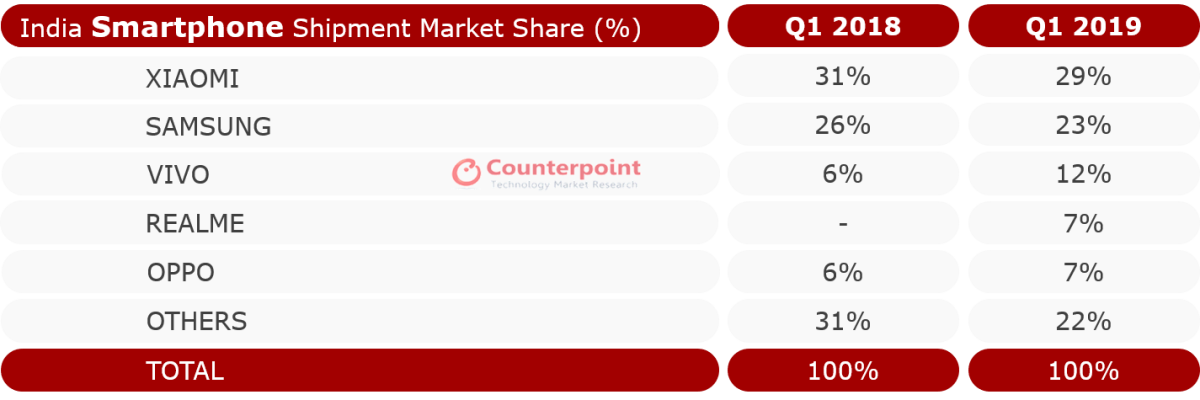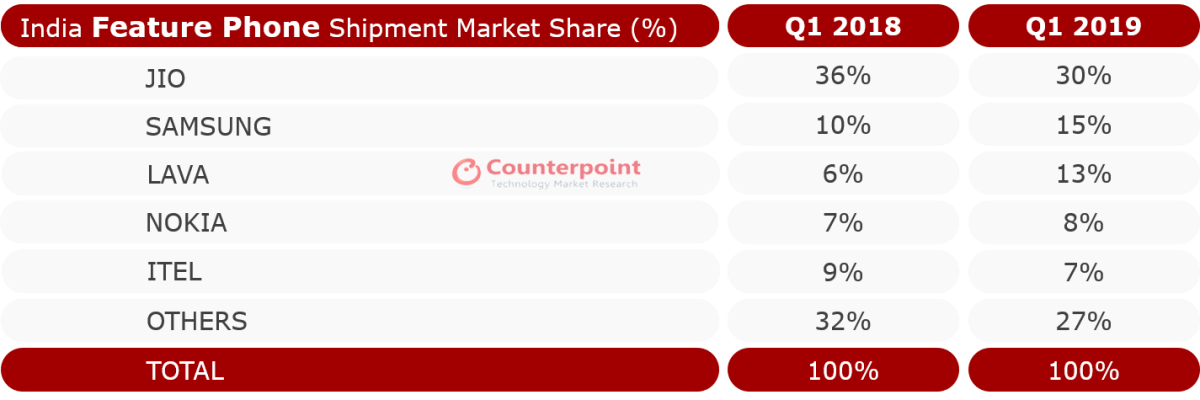- Xiaomi continues to lead the India smartphone market; Samsung leads the overall handset market during the quarter.
- Realme continues to figure among top five brands for the second successive quarter while Vivo’s market share reached its highest ever level in India in Q1 2019.
New Delhi, India, May 4, 2019 : The market share of Chinese brands in the Indian smartphone market reached a record 66% during Q1 2019, according to the latest research from Counterpoint’s Market Monitor service. Volumes for the Chinese brands grew 20% year-on-year (YoY) mainly due to the growth of Vivo, Realme, and OPPO.
While Vivo’s volume grew 119% YoY, OPPO grew 28% YoY. Vivo’s expanding portfolio in the mid-tier (₹7,000 – ₹14,000 or roughly US$100-US$180) drove its growth along with aggressive IPL campaign around flagship V series. OPPO, on the other hand, focused on expanding its portfolio in the less crowded ₹15,000 – ₹25,000 (roughly US$210-US$350) segment.
Commenting on the influx of Chinese brands, Tarun Pathak, Associate Director, said, “India’s smartphone market continues to attract a lot of attention from Global and Chinese players. Data consumption is on the rise and users are upgrading their phones faster as compared to other regions. This has led to users spending more on their purchase which is driving up the overall average selling price (ASP) in the market. As a result of this, the premium specs are now diffusing faster into the mid-tier price brands. We estimate this trend to continue leading to a competitive mid-tier segment in coming quarters.”
Overall, India’s overall smartphone shipments grew 4% YoY. The market started off to a slow start post record festive season, but demand started picking up later in the quarter. Commenting on the smartphone market, Anshika Jain, Research Analyst at Counterpoint Research said, “The overall growth was slower than expected as some of the major brands were sitting on inventory after a stock build up during the festive period last quarter. This quarter we have seen all major brands expanding their footprint in offline channels to gain market share. Xiaomi has laid out big plans for offline expansion by increasing its number of retail stores (Mi Preferred Partners), Mi Homes, and Mi Stores specifically to target smaller towns. Realme, which started as an online-only brand, now gets the majority of its sales from offline channels. OnePlus is also now increasing its offline points of sale by launching exclusive stores across key cities.”
Chinese brands also dominated the top 5 best-selling list. Xiaomi Redmi 6A remained the top model following multiple price cuts followed by Xiaomi Note 6 Pro, Redmi Y2, Samsung Galaxy M20, and Galaxy A50. The top 10 models contributed to 35% of overall smartphone shipments.
On the performance of different brands, Jain highlighted, “Xiaomi remains the market leader driven by new product launches. However, it faced strong market competition as compared to a year ago. Samsung did a major refresh in its product portfolio launching a new online-only M series. It also undertook a product refresh of the A series during the quarter. The new A series and M series launches quickly contributed to three-fifths of Samsung’s total smartphone shipments during the quarter. Vivo’s share reached its highest ever level in India, driven by the V15 series launch and an aggressive marketing campaign around the same. Realme continues to grow fast in India, leveraging on the strong momentum for its Realme 3 model during the quarter”
Exhibit 1: India Smartphone Market Share Q1 2019

Source: Counterpoint Research Market Monitor Q1 2019
While the smartphone market offers a big opportunity, one can’t ignore the 400 million feature phones users in the market which too is likely to stay for the next five years in India.
Exhibit 2: India Feature Phone Market Share Q1 2019

Source: Counterpoint Research Market Monitor Q1 2019
Market Summary:
- Xiaomi remained the smartphone market leader in Q1 2019 with a 29% share, though its shipments declined by 2% YoY. Its aggressive offline expansion and a strong focus on product build helped to retain its top position in the Indian smartphone market. Its newly launched Redmi Note 7 series (Note 7 and Note 7 Pro) crossed the one million mark within the first quarter of its launch. Xiaomi’s offline contribution was highest in March.
- Samsung’s A-series shipments surpassed two million units. The newly launched online-only M series started well too, but it will need a strong follow-up device to continue its momentum on the online platforms. Samsung’s recorded a strong sell-in of premium Galaxy S10 series which drove overall ASP for Samsung.
- Huawei’s ASP reached the highest-ever level driven by recently launched HONOR 10 Lite, HONOR View 20 and end of life for its entry-level segment. The brand continues to remain on the list of top ten smartphone brands.
- Other brands which did well during the quarter include ASUS, Tecno and Nokia HMD. ASUS’ lean portfolio with a focus on battery life and design in a competitive ₹8,000- ₹ 15,000 segment helped it to differentiate from the competition. Transsion’s Tecno is targeting offline entry-level smartphone segment with its aggressive offerings while Nokia HMD is looking to target quality conscious users with a value proposition around the latest Android version providing a great user experience. Transsion’s iTel, on the other hand, brings some industry-first features in sub-₹5,000 segment targeting first-time smartphone users.
- Indian brands reached their lowest ever share due to ongoing competition in the smartphone segment. Lack of refresh, strong competition and slow growth of the entry-level segment where they had strong share were some of the reason for their decline.
- In the premium segment, Samsung surpassed OnePlus to become the number one player driven by the good response for its newly introduced Galaxy S10 series.
- ₹15,000 – ₹20,000 was the fastest growing price band (240%) in Q1 2019.

























